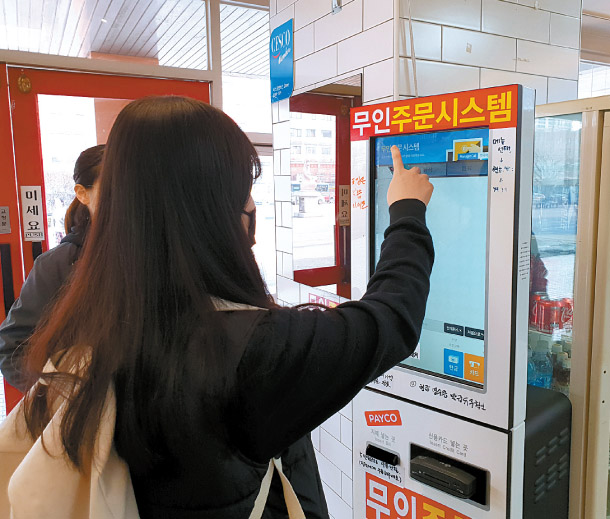Young like kiosk boom, but old get confused

A customer orders a meal on a kiosk at Express Bus Terminal in southern Seoul. [KIM DA-YOUNG]
A restaurant customer in her 20s said she’s happy with the new ordering system.
“Shy people are more comfortable with ordering with a device instead of talking to a person,” she said, and left the restaurant quietly after returning her tray through its self-service system.
The restaurant’s manager is pleased, too.
“I used 5 million won ($4,445) when I first installed the machine, but because it saves personnel expenses and the customers seem to like it, I think that it was the right choice,” said the manager, surnamed Jeon.
Kiosks are spreading to small restaurants, snack places, study rooms and hair shops. Market experts believe the machine-friendly younger generation is the reason that these kiosks are becoming popular, as many young people are more comfortable facing a machine than talking to restaurant staff. Employers don’t have to recruit employees, pay them or worry about retaining staff.
“If I want to hire a person, I have to post a job opening and continuously manage this person, but with a kiosk, these employment issues are solved,” said Kim Dong-shik, 50, who manages 10 kiosk-based snack shops in Seoul.
Kim originally employed an average of four part-timers at one of his snack shops. Personnel costs amounted to 3.5 million won to 4 million won a month. However, after installing kiosks that cost 4.5 million won each, he employs only one part-timer who manages the three shops, costing him 2 million won a month.
Kim added, “Employing workers meant thinking about meals, transportation, heating and air conditioning expenses, but now I don’t have to worry about them. As these shops are open 24 hours [a day], total sales have risen a great deal.”
Young people are often positive about these kiosks as they are familiar with electronic devices and feel stress when ordering in person in restaurants.
“It is convenient that I can order something on the kiosk with my credit card and food is served 5 to 10 minutes later,” said Gwak Joong-ho, 26, a college student.
However, some older people find the kiosks difficult to use. “Young people are familiar with these devices and can easily figure out how it works, but people like us can’t, even if someone teaches us,” said an elderly customer surnamed Seo, 66, who met friends at an automated coffee shop.
Analysts believe that kiosks are booming due to the increasing number of independent small businesses, the minimum wage increase and social isolation.
“In a situation where the unemployment rate increased and brought about an increase in small-scale individual start-ups, the minimum wage in 2019 was raised to 8,350 won per hour, which would amount to 10,030 won per hour when including the weekly holiday allowance,” said Kim Dae-jeong, a professor of business administration at Sejong University. “The use of kiosks spread to small businesses and self-employed people who had no countermeasures for the rise in personnel expenses.”
According to Kim, “This situation also fits perfectly with the younger generation as they are reluctant to face people and give their credit cards to others. This aligns with their consumption trend and influenced small businesses to become unmanned.”
Kiosk manufacturers are increasingly selling their devices to small businesses.
“Most people who are installing kiosks are individual entrepreneurs with little initial investment in their business. They feel pressured with taking on employees and are choosing to install kiosks from the start,” said Jang Seong-nam, CEO of TCJ System, which has been manufacturing and selling kiosks for over ten years. “There is difficulty introducing these devices in places that sell alcohol, where deferred payment is common, but in businesses where advance payment is possible, kiosks are becoming more common.”
BY KIM DA-YOUNG, YIM SEONG-BIN and JUNG MYUNG-SUK [jung.myungsuk@joongang.co.kr]










with the Korea JoongAng Daily
To write comments, please log in to one of the accounts.
Standards Board Policy (0/250자)